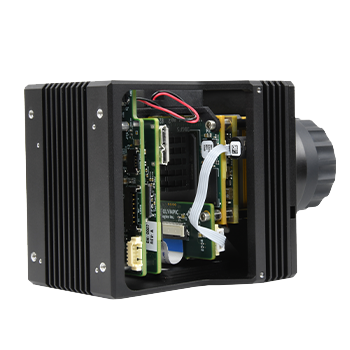The effectiveness of airborne search and rescue, navigation, and situational awareness tasks is predicated on the availability of high-resolution imagery that provides pilots with a clear picture and the widest possible field of view. While the human eye is extremely high resolution with an unmatched ability to detect high-spatial-frequency (HSF) objects across a wide field of regard, human vision can easily fatigue, is subject to environmental conditions, and is vastly degraded at night. Like human vision, multi-megapixel visible imaging cameras provide the best platform for the aforementioned tasks during daylight hours but quickly drop in sensitivity and become ineffective as night approaches. As a result, thermal infrared (IR) imaging has emerged as an effective 24/7 imaging technology for these applications.
The Need for Automation
The need for automation airborne search and rescue operations can materially benefit from the development and use of high-resolution sensors during both the day and night (Figure 1). In March 2014, when Malaysia Airlines Flight #370 disappeared in the Indian Ocean, the primary tools of the search and rescue efforts were human-piloted, fixed-wing and rotary aircraft, which scoured the ocean while crew members searched through binoculars. Even with the highest level of training for crew members and rescue pilots, the search operations were still hindered by the human condition, including fatigue and poor vision at night.

In this tragic, but glaring example, one must wonder if more effective, automated imaging technologies had been utilized, would it have benefited these search efforts? Nearly every organization involved in these types of search applications would like to conduct more effective operations at night; to achieve this goal, imaging technology needs to perform far better than the human eye. Algorithmic data processing can drastically improve the effectiveness of the cameras by using automated search and detection algorithms. The detection task uses specific algorithms to sift through thousands of false-alarm events that can occur over water — wave breaks or whitecaps, sun glint, cloud artifacts, reflection artifacts, etc. Programmers have spent substantial time and effort specifically on this task of sifting through the data and finding highly-positively correlating events that provide predictive-value-detection of objects in the water. This has been scaled to systems that are actively on aircraft today to validate the use-case during daytime with high resolution visible-imaging sensors; the results have been effective and encouraging. Simultaneously, high-magnification queued sensors are being used for the inspection of detection events. In the visible spectrum, this technology is nearly ready for deployment on small tactical unmanned aircraft systems or STUAS-class robotic aircraft. While automation technology can improve the effectiveness of search operations, IR imaging technology can extend the operational use through the night, in bad weather conditions, and can provide a wide field of view (FOV) for monitoring large areas of the ocean. Camera technology utilizing IR energy far beyond what the human eye can see will provide significant benefits over visible-imaging cameras. At night, visible-imaging cameras would require active illumination that provides a narrow field of view, which is contrary to the application of wide-area surveillance. Passive technology using shortwave infrared (SWIR), midwave infrared (MWIR), and longwave infrared (LWIR) imaging are ideal for wide-area surveillance because they do not rely on external illumination. Of these, LWIR is the most prevalent detector technology due to its lower cost, high resolution, high sensitivity, ease of export, and independence from atmospheric nightglow.
A Brief History of Thermal Imaging Surveillance
Historically, IR imaging has been limited by low resolution in comparison to visible imaging, but today, the IR industry is on the verge of a mini-revolution with the development and commercialization of high definition (HD) sensors. This evolution is poised to improve the effectiveness of airborne search and rescue, navigation, and situational awareness operations at night.
LWIR thermal imager provides true HD resolution for a variety of surveillance and search & rescue operations. The technological capability of IR technology has followed two different tracks in the last 25 years — that which was developed and used exclusively by the military and that which was available for use commercially. The vast majority of commercially available IR sensors sold today were developed in the early 1990s and provide standard definition (SD) 640 x 512 resolution or less. Higher resolution technology was developed in the late 2000s, but these were research-grade, cooled MWIR sensors for military use. Within the last five years, 1024 x 768 resolution LWIR and cooled MWIR 1280 x 1024 and 1920 x 1576 cameras have also moved from the military arena into the commercial space.
HD Thermal Imaging for Surveillance
Today, while higher resolution technology remains constrained to use within military programs, January 2017 marked the next evolution in thermal IR camera technology with the release of the first commercially-available 1920 x 1200 uncooled LWIR camera. In an effort to accelerate the use of advanced infrared imaging, primarily for airborne search and rescue, navigation, and situational awareness applications, Sierra-Olympia (Hood River, Oregon) recently developed the Vayu HD uncooled LWIR thermal camera (Figure 2). The imager provides true HD resolution at 1920 x 1200 with a 12μm pixel pitch and, most importantly, is now commercially available.




The new high-resolution thermal imager uses an uncooled vanadium oxide (VOx) detector, provides 1080p video output via HD-SDI or H.264-IP compression over Ethernet, and has an IP67-rated environmental enclosure for rugged, extreme outdoor conditions (Figure 3). Full HD resolution IR sensors with a wide FOV are now available to provide the highest degree of situational awareness and visual navigation at night. Additionally, these new sensors are uncooled, which affords long life and lower expense while maintaining very high thermal imaging performance. Early deployment of test systems for search and rescue, navigation, and situational awareness operations is currently underway, which will help determine the full value of HD resolution sensors in the search and rescue application area.

